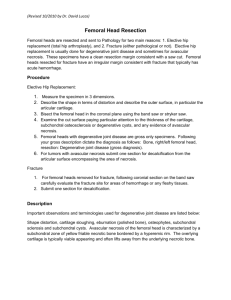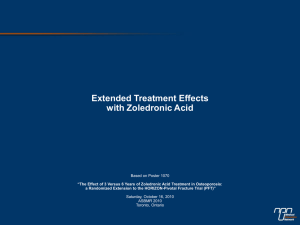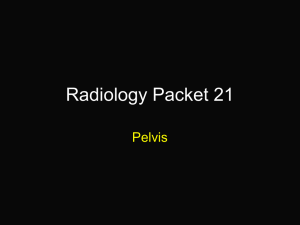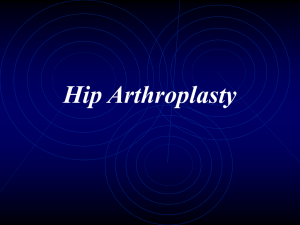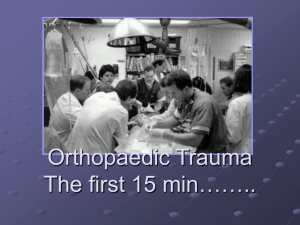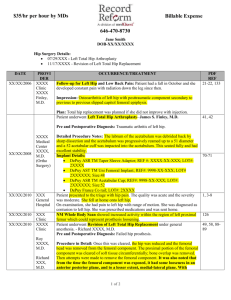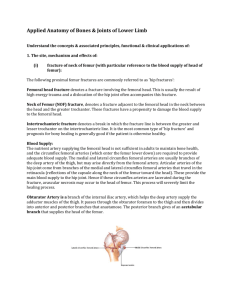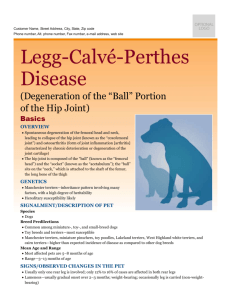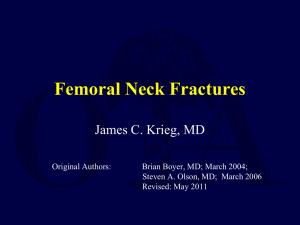hip - Pilgrims Hospital
advertisement
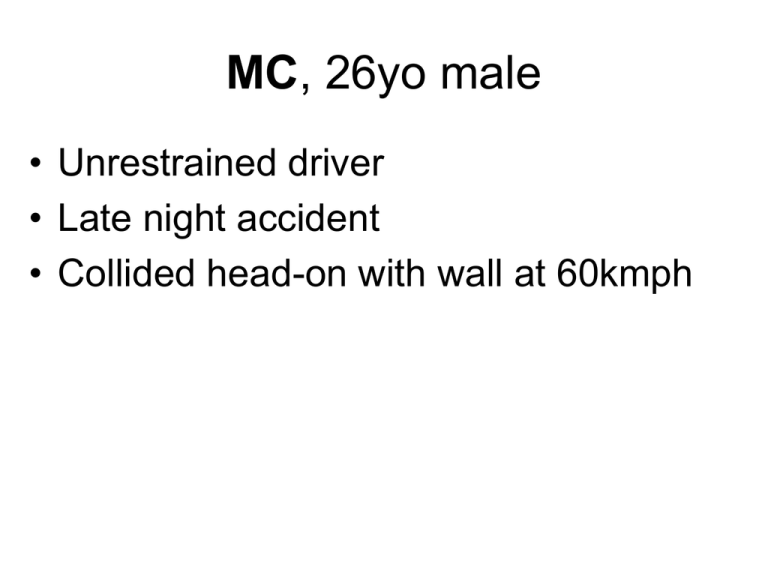
MC, 26yo male • Unrestrained driver • Late night accident • Collided head-on with wall at 60kmph MC, 26yo male • • • • • Brought to ED by ambulance Isolated left lower limb injury Hip flexed, adducted, internally rotated Severe pain on attempted motion of hip No peripheral neurological/vascular deficit Diagnosis • Posterior dislocation of left hip • Loose bone fragment – from ?posterior wall of acetabulum vs. femoral head • Immediate attempt of reduction in ED under sedation – failed • Brought to OR • Hip reduced under GA Post-manipulation CT • Hip joint reduced • Acetabulum intact • Fracture of femoral head below the fovea (insertion of ligamentum teres) • Rotation of fractured fragment noted Treatment • Patient brought to OR • ORIF of femoral head • Anterolateral approach to hip with trochanteric slide osteotomy • Circulation-sparing approach Treatment • Fragment anatomically reduced and fixed with three screws • Troch osteotomy closed with screws • Mobilised postoperatively • Well at two months follow-up Dislocations of hip • High-energy trauma • Usually unrestrained occupants in MVA • Also pedestrian MVA, falls from height, industrial accidents • 50% associated with fractures elsewhere Posterior Dislocation • Most common – over 90% • Axial load applied to femur while hip flexed • Impact of knee on dashboard Associated Injuries • • • • • Head, neck, face Chest /intra-abdominal injuries 50% have fractures elsewhere! Sciatic nerve injuries 10% to 20%! Thorough exam essential Vascular supply • Branches of profunda femoris – medial and lateral femoral circumflex • Ascending branches are kinked/compressed in hip dislocation Management • • • • • • • Dislocated hip is an emergency Full trauma survey Reduction restores blood flow through compressed vessels Goal to decrease risk of AVN and DJD AVN 5% with early reduction within 6 hours AVN 15% with reduction within 12 hours AVN 30% when reduction delayed >12 hours Reduction manoeuvre (Allis) • • • • • Patient supine Assistant stabilises pelvis Slowly flex hip to 900 Traction in line of femur Adduction and internal rotation • Reduction often seen and felt Post-reduction management • CT of affected hip (thin 2mm cuts) • Look for congruency of reduction, loose fragments • Mobilise early • Touch down weight-bearing 4-6 weeks • ROM precautions: no adduction, no internal o rotation, no flexion > 60 • AVN can occur up to 2-5 years Open reduction • Rarely needed • Dislocations irreducible by closed means – Soft tissue interposition – Femoral head buttonholed through capsule • Nonconcentric reduction • Fracture of femoral neck/head/acetabulum Prognosis • • • • AVN 5% to 30% Posttraumatic OA most frequent Recurrent dislocation 2% Neurovascular injury 10%-20% – Sciatic nerve – Prognosis unpredictable but 50% full recovery • Heterotopic ossification 2% • VTE 50% Femoral head fractures • • • • Rare injuries Almost all complicate hip dislocations 10% of posterior hip dislocations Fracture occurs by shear as femoral head dislocates • History and presentation as in hip dislocation • Patient posture may be less extreme Pipkin Classification JBJS, 1957 I II III IV Fracture inferior to fovea Fracture superior to fovea Fracture of femoral head with fracture of femoral neck Fracture of femoral head with fracture of acetabulum Pipkin, JBJS, 1957 Femoral head fractures - treatment • Pipkin 1 – closed treatment – If reduction adequate (<1mm step-off) – If reduction not adeuate – ORIF – Small fragments can be excised • Pipkin 2 – involve weighbearing surface – Same recommendations but only anatomical reduction can be accepted with closed treatment – Prognosis for AVN same as in simple dislocations Approach to hip for fractures of femoral head Helfet, Lorich et al, J Orthop Trauma, 2005 Trochanteric slide osteotomy Femoral head fractures - treatment • Pipkin 3 – femoral head fracture with associated fracture of neck – Prognosis is poor - 50% AVN • Pipkin 4 – femoral head fracture with associated fracture of acetabulum – Acetabular fracture must be treated with ORIF – Femoral head must also be treated with ORIF to allow early motion – Prognosis variable - depends on acetabular fracture Literature • 1. Yoon TR et al Clinical and radiographic outcome of femoral head fractures: 30 patients followed for 3-10 years. Acta Orthop Scand. 2001 Aug;72(4):348-53 • 2. Asghar FA, Karunakar MA. Femoral head fractures: diagnosis, management, and complications. Orthop Clin North Am. 2004 Oct;35(4):463-72 • 3: Brooks RA, Ribbans WJ. Diagnosis and imaging studies of traumatic hip dislocations in the adult. Clin Orthop Relat Res. 2000 Aug;(377):15-23 • 4: DeLee JC, Evans JA, Thomas J. Dislocation of the hip and associated femoral-head fractures. J Bone Joint Surg Am. 1980 Sep;62(6):960-4 • 5. Henle P, Kloen P, Siebenrock KA. Femoral head injuries: Which treatment strategy can be recommended? Injury. 2007 38(4):478-88
